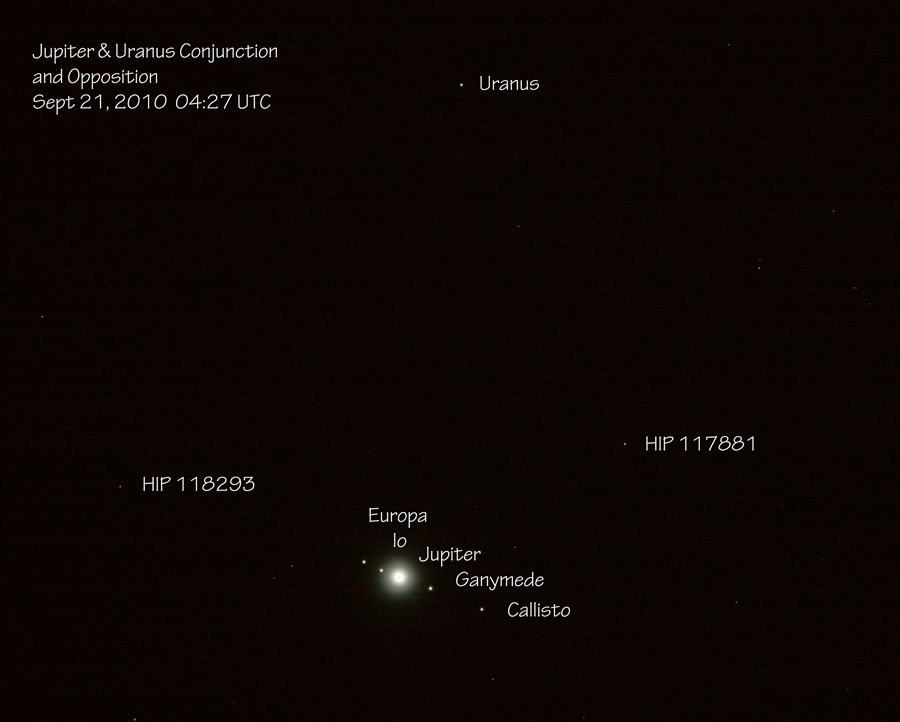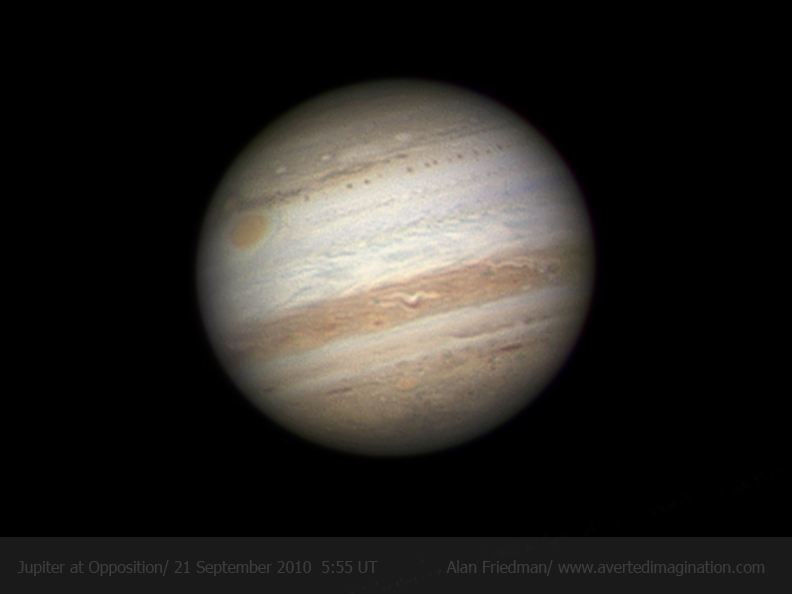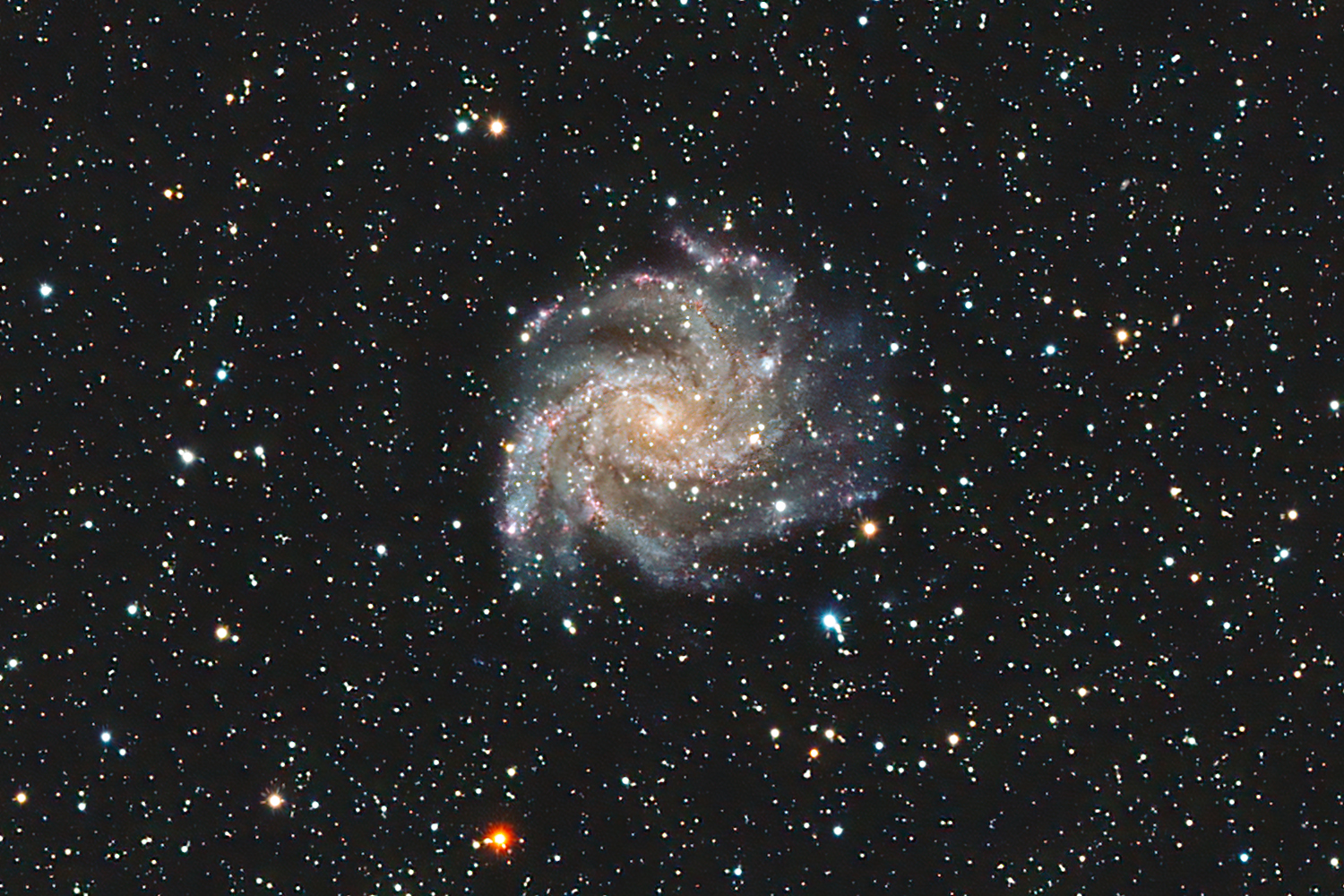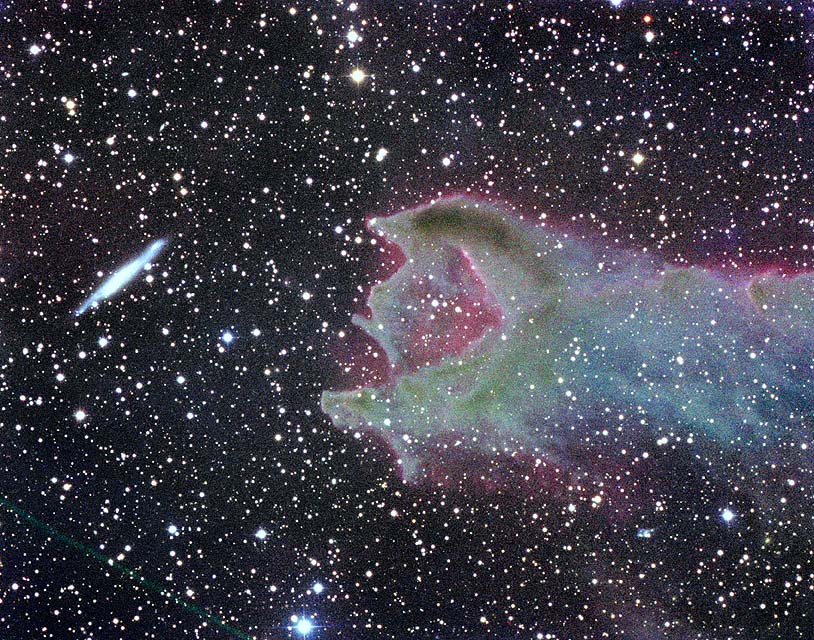Page 1 of 1
Recent Submissions: 2010 September 21-24
Posted: Sun Sep 19, 2010 9:46 pm
by owlice
__________________________________________________________________________________
While I'm away from Asterisk, please post your images here for September 21-24.
If you need instructions for posting images, please see
this thread.
Thank you very much!!
Owlice
 __________________________________________________________________________________
<- Previous submissions
__________________________________________________________________________________
<- Previous submissions
Jupiter and Uranus Conjunction
Posted: Tue Sep 21, 2010 6:29 pm
by Guest
Jupiter and Uranus Conjunction
http://www.spike-a.com/jupiteruranus/
Copyright: John Wunderlin
Galactic Glories around a Supercluster: Abell 1680
Posted: Tue Sep 21, 2010 7:07 pm
by LLacertae
Galactic Glories around a Supercluster: Abell 1680
http://hubble-unseen.at.tf
Copyright: Nikolaus Sulzenauer HST/NASA/ESA
Do you see the blueish merger in the center of the picture? Isn't that a green filament, which is coming out of its nucleus?! Some kind of Voorwerpje?

Luna and Venus over Canigou
Posted: Tue Sep 21, 2010 7:49 pm
by Guest
Luna and Venus over Canigou
Geert Catteeuw
Re: Recent Submissions: 2010 September 21-24
Posted: Tue Sep 21, 2010 10:37 pm
by geissi
Fireworks on our sun
These pretty prominences have been captured on 22th September 2010
with a TEC 140 APO, 160 mm Baader D-ERF and a SolarSpectrum 0.5A ASO H-alpha system.
Camera was a Point Grey Grashopper with an ICX285 CCD-chip.
Exposure 3.3 ms / 1000 Frames
And even some more:
Enjoy!
Regards
Rolf Geissinger
Re: Recent Submissions: 2010 September 21-24
Posted: Wed Sep 22, 2010 1:25 pm
by Sungazer
Solar Activity on the Rise
http://sungazer.net/092110.html
Copyright: Greg Piepol sungazer.net
Coronado SolarMax 90 Hydrogen-Alpha
Lumenera SKYnyx 2-2 video camera
7 frames captured, stacked and processed
Enjoy the sun!
Greg Piepol
Re: Recent Submissions: 2010 September 21-24
Posted: Wed Sep 22, 2010 6:59 pm
by chrishet
I was fortunate to see Mondays rollout of Discovery to Pad 39A. Just after sunset Venus appeared as the shuttle began its long trek to the pad.
Venus and Discovery
http://hetlage.com
Copyright: Chris Hetlage
Re: Recent Submissions: 2010 September 21-24
Posted: Thu Sep 23, 2010 12:27 am
by terry.hancock
Re: Recent Submissions: 2010 September 21-24
Posted: Thu Sep 23, 2010 3:06 pm
by StefanoDeRosa
Super Harvest Moon and super bright Jupiter over Turin
http://ofpink.wordpress.com/
Copyright: Stefano De Rosa
Re: Recent Submissions: 2010 September 21-24
Posted: Thu Sep 23, 2010 3:49 pm
by alanfgag
This may be election season in the U.S., but there is no debate here - Jupiter rules the night sky! This image was captured four hours before the earth, sun and Jupiter reached opposition... captured from my downtown Buffalo backyard with a 10" telescope.
http://www.avertedimagination.com/img_p ... ition.html
clear skies and best wishes,
Alan
http://www.avertedimagination.com
Re: Recent Submissions: 2010 September 21-24
Posted: Thu Sep 23, 2010 4:34 pm
by nafpie
Half of the Sky
Link to a larger version (1500x1144px)
That one is from Egypt.
It shows the Sinai dessert with the summer milkyway and Jupiter (at the left) above it. In fact, the fisheye lens I used was able to capture the half of the whole sky with one shot (180°).
During the exposure time, a flashlight in the hand of the man was fired to illuminate the people as well as parts of the foreground. The light at the mountains in the background are illuminated by the lights of Dahab city.
Location: Near Dahab, Egypt
Date: 2010-09-05
Time: 20:30 local time (18:30 UT)
Camera: Canon EOS 5D Mark II digital SLR camera
Lens: Sigma 8mm F/3.5 Fisheye
Exposure time: 45 sec.
Aperture: 1:3.5
ISO: 6400
Single shot, no composite
Not much image processing at all
Thanks for looking!
Best wishes,
Stefan
-----------------------
Mail:
stefan.seip@t-online.de
Member of
TWAN
Web:
http://www.astromeeting.de
-----------------------
Fireworks Galaxy NGC 6946 & surrounding milkyway
Posted: Thu Sep 23, 2010 11:01 pm
by sternklar
The image shows the galaxy NGC 6946 on the Cepheus/Cygnus border, hiding behind lots of stars of our milkyway (which is
a very untypical position for a galaxy). NGC 6946 is also quite dim - because its light has to travel trough lots of interstellar gas and dust - and is known for its
many supernovae (9) within the last 100 years. The deeply red star below NGC 6946 is quite an exotic objekt, namely a
carbon star (V778 Cyg) with a very dirty atmosphere..
The picture was taken with a Takahashi TOA 150/1100 Apo refractor and SBIG STL-11000M CCD-Camera.
The exposure time was 210 minutes (total) through Baader-RGB-filters (1x1 binning).
My location was on a mountain pass in the Swiss Alps (1600 meters above sea level), 12 days ago (on the 11th september 2010).
Clear skies
Manuel
(
http://www.sternklar.ch)
Re: Recent Submissions: 2010 September 21-24
Posted: Thu Sep 23, 2010 11:05 pm
by dspole
Green flash during sunrise at the South Pole
This photo was taken a few days ago and shows the green flash that sometimes occurs during sunrise and set. At the South Pole we share the longest sunrise on the planet and when the conditions are correct can catch a glimpse of the both green and the more rare blue flashes multiple times for over a day around the equinox.
Best Wishes,
Daniel
Re: Fireworks Galaxy NGC 6946 & surrounding milkyway
Posted: Fri Sep 24, 2010 3:17 am
by Ann
sternklar wrote:The image shows the galaxy NGC 6946 on the Cepheus/Cygnus border, hiding behind lots of stars of our milkyway (which is
a very untypical position for a galaxy). NGC 6946 is also quite dim - because its light has to travel trough lots of interstellar gas and dust - and is known for its
many supernovae (9) within the last 100 years. The deeply red star below NGC 6946 is quite an exotic objekt, namely a
carbon star (V778 Cyg) with a very dirty atmosphere..
The picture was taken with a Takahashi TOA 150/1100 Apo refractor and SBIG STL-11000M CCD-Camera.
The exposure time was 210 minutes (total) through Baader-RGB-filters (1x1 binning).
My location was on a mountain pass in the Swiss Alps (1600 meters above sea level), 12 days ago (on the 11th september 2010).
Clear skies
Manuel
(
http://www.sternklar.ch)
Yes, I found a carbon star near NGC 6946. Its GSC designation is 4246 1005 1, and its color indexes are, BT magnitude 15.667 plus/minus 0.896, and VT magnitude 10.505 plus/minus 0.044. So it's about five magnitudes brighter in Vt than in BT. That's a lot!
Ann
Cometary Globules in Puppis
Posted: Fri Sep 24, 2010 6:05 am
by marco lorenzi
Cometary Globules in Puppis
http://www.glitteringlights.com
Copyright: Marco Lorenzi
This is an area of the GUM Nebula rarely imaged but full of interesting objects, in particular cometary globules.
Above are both the normal version and a labeled version where I reported several objects I was able to track down from Simbad database.
The image was taken with a Pentax 67 300mm EDIF photo lens covering an area of 7x7 degrees, centered at RA 07h25' and DEC -46d 00'
The total exposure lasted about 320 minutes through Ha LRGB filters.
From my new home link reported above page is also possible to access a "zoomable" version up to 4k x 4k pixels resolution.
Clear Skies
Marco
http://www.glitteringlights.com
Re: Recent Submissions: 2010 September 21-24
Posted: Fri Sep 24, 2010 3:41 pm
by bystander
All these images are really wonderful, but please keep the image sizes down. People are not going to want view them when it takes too long to load the page. Please keep your image displays to less than 300k. You can provide links to the originals for people who are interested in seeing a higher resolution.
Thank you
Re: Recent Submissions: 2010 September 21-24
Posted: Fri Sep 24, 2010 6:05 pm
by Alvaro Gaviria cano
Re: Recent Submissions: 2010 September 21-24
Posted: Fri Sep 24, 2010 6:24 pm
by photojhh
Moon, Uranus, and Jupiter's Moons, Single Exposure
Copyright: John H. Harms
This is a single-exposure photo showing the Moon, Uranus, and Jupiter with three of its moons. I had been trying for awhile to get Jupiter's moons and our Moon in the same shot with the same exposure, and the clouds finally cooperated Wednesday night (9/22/2010, 10:23p Pacific Time). This time there was a bonus: Uranus.
There have been prior APOD shots using clouds to filter the Moon's overwhelming light for a single-exposure shot (including one of my own for Mars, ap071223). However, I believe this is the first one that shows Uranus and Jupiter's moons together with our Moon not completely blown out.
Here is an annotated version for a mouse-over alternate image:
http://farm5.static.flickr.com/4142/502 ... e3bd_o.jpg
Exposure was 0.5 seconds, f/5.6, ISO 800 using a Canon 400D DSLR with a 70-300 zoom lens set to 135mm. Post-processing of the RAW image was done with Digital Photo Professional v3.8.
Full-resolution version can be downloaded from my Flickr page:
http://www.flickr.com/photos/harmsfam/5020397743/
Or, directly from here:
http://farm5.static.flickr.com/4113/502 ... bddf_o.jpg
-- JohnH
Re: Recent Submissions: 2010 September 21-24
Posted: Fri Sep 24, 2010 7:20 pm
by Ann
That's a wonderful picture, Marco Lorenzi. Exactly my kind of picture too. Puppis is a very beautiful constellation, full of interesting nebulosity and noteworthy stars, the greatest of which is O5 supergiant Zeta Puppis.
In your image you have captured a lot of fascinating cometary globules. And just like the kind of comets that we know in our own solar system, the cometary globules have "tails" that "point away" from a sun. What sun is that? What sun is responsible for creating all those cometary globules with tails all pointing in the same direction, to the right in the image? Is the "cometary-blowing star"Zeta Puppis? It doesn't look that way to me. Instead, it appears that all the cometary globules here have their tails pointing away from Gamma Velorum. Gamma Velorum is one of the most extreme stars in the moderately nearby part of the galaxy, because it is considerably nearer to us than Eta Carina. Gamma Velorum is an incredible binary star, made up of one O-type supergiant and one super-hot Wolf Rayet star.
So if you look closer at the cometary globules in Marco Lorenzi's picture, you'll see that they all have their tails "blown to the right". And indeed, Gamma Velorum would be to the left here, even though it is too far to the left to show up in the picture.
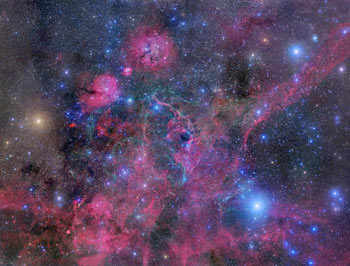
This is the Vela supernova remnant by Robert Gendler. Note the very bright blue star at lower right, at about five o'clock. That's Gamma Velorum, the star responsible for blowing all the cometary globules in Puppis. The second brightest blue star in the picture, at upper right at about two o'clock, is Zeta Puppis. The Puppis skyscape with all the cometary globules photographed by Marco Lorenzi would be off the frame to the right here.
This is David Malin's famous picture of the cometary globule that is called "hand of God" in Marco Lorenzi's image.
Also note galaxy NGC 2427 in Marco Lorenzi's image. It's a wonder that we see much of this galaxy at all, since there is so much Milky Way gas and dust between the galaxy and us. I apologize for the bad picture here, but that was the best I could do!

Ann
Andromeda and Friends
Posted: Sat Sep 25, 2010 12:49 am
by Anthony Licata
Andromeda and Friends
Anthony Licata

